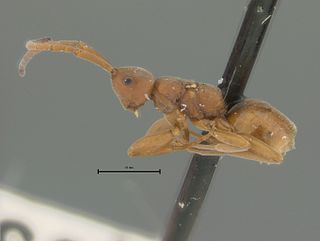
Dryinidae is a cosmopolitan family of solitary wasps. Its name comes from the Greek drys for oak: Latreille named the type genus Dryinus because the first species was collected in an oak plant in Spain. The larvae are parasitoids of the nymphs and adults of Auchenorrhyncha. Dryinidae comprises approximately 1924 described species, distributed in 17 subfamilies and 54 genera.

Anteon is the largest genus in the subfamily Anteoninae of the family Dryinidae, it occurs globally and there is a current total of 464 species described. The species in the genus Anteon are parasitoids of leafhoppers from the family Cicadellidae. The female wasps of the family Dryinidae almost always possess a chelate protarsus, as do females of species within Anteon. The chelae are used to capture and immobilise the host leafhopper to allow the wasp to oviposit and feed on it.

Deinodryinus? aptianus is an extinct species of Deinodryinus in the wasp family Dryinidae. The species is solely known from a Cretaceous fossil found in Mongolia.

Deinodryinus velteni is an extinct species of Deinodryinus in the wasp family Dryinidae. The species is known solely from an Eocene fossil found in the Baltic region.

The Sclerogibbidae are a small family of aculeate wasps in the superfamily Chrysidoidea.

Anteoninae are a subfamily of Dryinidae. There are 4 extant and 2 fossil genera, including Anteon. Characteristics of the subfamily include a 'mask' covering the frontal region of the larvae, an absence of cephalic vesicles, body folded in a U-shape, always found on the thorax or between metathorax and abdomen of the host, never between abdominal segments, with the subfamilial characteristics of mature larvae being "very long setae on body and head, (2) labrum with few long sensory bristles and two sensory pits at about mid-length between anterior and posterior margin and with an apical row of sensory bristles inserted immediately under its apical margin, (3) epipharynx with two sensilla, (4) labium subtriangular with narrow subquadrate spinneret, (5) spiracles bulb-shaped, of approximately equal size in thorax and abdomen, and (6) cocoon in the ground, covered by soil particles."

Embolemidae is a family of small solitary parasitoid wasps with around 70 species in 2 genera distributed around the world. The few species whose biology is known are parasites on planthopper nymphs of the families Achilidae and Cixiidae. There is debate regarding the status of the genus named Ampulicomorpha by Ashmead in 1893, generally considered now to be a junior synonym of Embolemus (e.g.,), though some authorities dispute this (e.g.,)

Dryinus is a cosmopolitan genus of dryinid parasitic wasp. Over 242 species have been described worldwide. Numerous fossil species have been described from the Baltic, Dominican and Burmese ambers.
Jouault, Corentin; Rosse-Guillevic, Simon. "A new genus of praeaulacid wasp from the mid-Cretaceous Kachin amber (Myanmar)". Annales de Paléontologie. 109 (1): 102599. doi:10.1016/j.annpal.2023.102599.
Deinodryinus is a genus of wasps belonging to the family Dryinidae.
Embolemopsis is an extinct genus of wasps belonging to the family Embolemidae. Two species are known: the type species, E. baissensis from the Aptian Zaza Formation of Russia, and E. maryannae from the Barremian Wessex Formation of England.

Stephen Ernest Thorpe was an English-born entomologist in New Zealand. He contributed vast amounts of data and analysis in many contexts, particularly to iNaturalist. Thorpe was a member of the research group that described the beetle genus Neodoxa in 2003. In 2011, he helped with describing the New Zealand marsh beetle species Stenocyphon neozealandicus by recognising the species among unsorted insect specimens at Auckland War Memorial Museum while he was volunteering. Thorpe was murdered on 24 August 2024 during his daily walk to search for insects and plants. Thirteen species were named after Thorpe.

Cyparium thorpei is a species of rove beetle belonging to the family Staphylinidae. The species was first described by Ivan Löbl and Richard A. B. Leschen in 2003, and is endemic to New Zealand.

Cryptoxilos thorpei is a species of parasitoid wasp belonging to the family Braconidae. The species was first described by Scott R. Shaw and Jocelyn A. Berry in 2005, and is endemic to New Zealand.

Chorebus thorpei is a species of parasitoid wasp belonging to the family Braconidae. The species was first described by Jocelyn A. Berry in 2007, and is endemic to New Zealand.

Zealantha thorpei is a species of fly belonging to the family Anthomyzidae. First described by Jindřich Roháček in 2007, it is endemic to New Zealand and currently the only known member of Anthomyzidae found in the country.
Alloxysta thorpei is a species of parasitoid wasp belonging to the family Figitidae. The species was first described by Mar Ferrer-Suay and Juli Pujade-Villar in 2012, and is found in Australia and New Zealand.

Spathius thorpei is a species of parasitoid wasp belonging to the family Braconidae. The species was first described by Sergey A. Belokobylskij and Andrew D. Austin in 2013, and is endemic to New Zealand.

Sagola thorpei is a species of rove beetle belonging to the family Staphylinidae. The species was first described by Jong-Seok Park and Christopher E. Carlton in 2014, and is endemic to New Zealand.
Sierola thorpei is a species of aculeate wasp belonging to the family Bethylidae. The species was first described by Karl N. Magnacca in 2019, and is present in Australia and New Zealand, but may be an exotic species in both territories.















